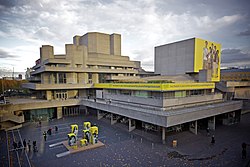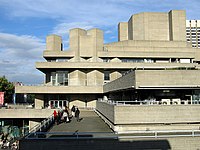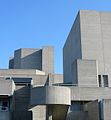Royal National Theatre
| National Theatre | |
|
Surrey | |
|---|---|
 The National Theatre from Waterloo Bridge | |
| Type: | Theatre |
| Location | |
| Grid reference: | TQ30988036 |
| Location: | 51°30’25"N, 0°6’51"W |
| Town: | Lambeth |
| History | |
| Built to 1976 | |
| By: | Denys Lasdun |
| Theatre | |
| Brutalist | |
| Information | |
| Website: | nationaltheatre.org.uk |
The Royal National Theatre (generally known as the National Theatre) stands on the south bank of the River Thames in Lambeth, Surrey. It is one of the United Kingdom's three most prominent publicly funded performing arts venues, alongside the Royal Shakespeare Company and the Royal Opera House.
From its foundation in 1963 until 1976, the company was based at the Old Vic theatre in Waterloo, Lambeth. The current building is located next to the Thames in the South Bank area of Lambeth, in a large cultural complex alongside the concert halls, galleries and venues of the Southbank Centre and BFI Southbank, though independent of all of them.
Since 1988, the theatre has been permitted to call itself the Royal National Theatre, but the full title is rarely used. The theatre presents a varied programme, including Shakespeare and other international classic drama; and new plays by contemporary playwrights. Each auditorium in the theatre can run up to three shows in repertoire, thus further widening the number of plays which can be put on during any one season.
In addition to performances at the National Theatre building, the National Theatre company tours productions at theatres across the United Kingdom. In June 2009, the theatre began 'National Theatre Live', a programme of simulcasts of live productions to cinemas, first in the United Kingdom and then internationally. The programme began with a production of Phèdre, starring Helen Mirren, which was screened live in 70 cinemas across the United Kingdom. NT Live productions have since been broadcast to over 1,000 venues in 35 countries around the world.
Origins
In 1847, a critic using the pseudonym Dramaticus published a pamphlet[1] describing the parlous state of British theatre. Production of serious plays was restricted to the patent theatres, and new plays were subjected to censorship by the Lord Chamberlain's Office. At the same time, there was a burgeoning theatre sector featuring a diet of low melodrama and musical burlesque; but critics described British theatre as driven by commercialism and a 'star' system. There was a demand to commemorate serious theatre, with the "Shakespeare Committee" purchasing the playwright's birthplace for the nation demonstrating a recognition of the importance of 'serious drama'. The following year saw more pamphlets on a demand for a National Theatre from London publisher Effingham William Wilson.[2] The situation continued, with a renewed call every decade for a National Theatre. Attention was aroused in 1879 when the Comédie-Française took a residency at the Gaiety Theatre, described in The Times as representing "the highest aristocracy of the theatre". The principal demands now coalesced around: a structure in the capital that would present "exemplary theatre"; that would form a permanent memorial to Shakespeare; a supported company that would represent the best of British acting; and a theatre school.[3]
The Shakespeare Memorial Theatre was opened in Stratford upon Avon on 23 April 1879, with the New Shakespeare Company (now the Royal Shakespeare Company); and Herbert Beerbohm Tree founded an Academy of Dramatic Art at Her Majesty's Theatre in 1904. This still left the capital without a national theatre. A London Shakespeare League was founded in 1902 to develop a Shakespeare National Theatre and – with the impending tri-centenary in 1916 of his death – in 1913 purchased land for a theatre in Bloomsbury. This work was interrupted by the First World War.
In 1910, George Bernard Shaw wrote a short comedy, The Dark Lady of the Sonnets, in which Shakespeare himself attempts to persuade Elizabeth I of the necessity of building a National Theatre to stage his plays. The play was part of the long-term campaign to build a National Theatre.
Finally, in 1948, the London County Council presented a site close to the Royal Festival Hall for the purpose, and a "National Theatre Act", offering financial support, was passed by Parliament in 1949.[4] Ten years after the foundation stone had been laid in 1951, the Government declared that the nation could not afford a National Theatre; in response the Council offered to waive any rent and pay half the construction costs. Still, the Government tried to apply unacceptable conditions to save money; attempting to force the amalgamation of the existing publicly supported companies: the RSC, Sadler's Wells and Old Vic.[4] It took until July 1962 for agreements to be reached and boards set up to supervise construction, and to run a National Theatre Company. The "National Theatre Company" opened on 22 October 1963 with Hamlet, presented at the Old Vic.
The current building was designed by architects Sir Denys Lasdun and Peter Softley and structural engineers Flint & Neill and contains three stages, which opened individually between 1976 and 1977.[5] The construction work was carried out by Sir Robert McAlpine.[6]
The Company was to remain at the Old Vic until 1977, when construction of the Olivier Theatre was complete.[4]
Architecture
The style of the National Theatre building was described by Mark Girouard as "an aesthetic of broken forms" at the time of opening. Architectural opinion was split at the time of construction. Even enthusiastic advocates of the Modern Movement such as Sir Nikolaus Pevsner have found the Béton brut concrete both inside and out overbearing. Most notoriously, Prince Charles described the building in 1988 as "a clever way of building a nuclear power station in the middle of London without anyone objecting". Sir John Betjeman, however, a man not noted for his enthusiasm for brutalist architecture, was effusive in his praise and wrote to Lasdun stating that he "gasped with delight at the cube of your theatre in the pale blue sky and a glimpse of St. Paul's to the south of it. It is a lovely work and so good from so many angles...it has that inevitable and finished look that great work does."[7]
Despite the controversy, the theatre has been a Grade II* listed building since 1994.[8]
Although the theatre is often cited as an archetype of Brutalist architecture in Britain, since Lasdun's death the building has been re-evaluated as having closer links to the work of Le Corbusier, rather than contemporary monumental 1960s buildings such as those of Paul Rudolph.[9] The carefully refined balance between horizontal and vertical elements in Lasdun's building has been contrasted favourably with the lumpiness of neighbouring buildings such as the Hayward Gallery and Queen Elizabeth Hall.
The theatre is now in the unusual situation of having appeared simultaneously in the top ten "most popular" and "most hated" London buildings in opinion surveys. A recent lighting scheme illuminating the exterior of the building, in particular the fly towers, has proved very popular, and is one of several positive artistic responses to the building.
The National Theatre building houses three separate auditoria. Additionally, a temporary structure was added in April 2013 and closed in May 2016.
Olivier Theatre
Named after the theatre's first artistic director, Laurence Olivier, this is the main auditorium, modelled on the ancient Greek theatre at Epidaurus; it has an open stage and a fan-shaped audience seating area for 1100 people. A 'drum revolve' (a five-storey revolving stage section) extends eight metres beneath the stage and is operated by a single staff member. The drum has two rim revolves and two platforms, each of which can carry ten tonnes, facilitating dramatic and fluid scenery changes. Its design ensures that the audience's view is not blocked from any seat, and that the audience is fully visible to actors from the stage's centre. Designed in the 1970s and a prototype of current technology, the drum revolve and a multiple 'sky hook' flying system were initially very controversial and required ten years to commission, but seem to have fulfilled the objective of functionality with high productivity.[10]
Lyttelton Theatre
Named after Oliver Lyttelton, 1st Viscount Chandos, the National Theatre's first board chairman, it has a proscenium arch design and can accommodate an audience of 890.
Dorfman Theatre
Named after Lloyd Dorfman (philanthropist and chairman of Travelex Group, who provided funds),[11] the Dorfman is " the smallest, the barest and the most potentially flexible of the National Theatre houses . . . a dark-walled room", audience capacity 400.[12] It was formerly known as the Cottesloe (after John Fremantle, 4th Baron Cottesloe, chairman of the South Bank Theatre board), a name which ceased to be used with the theatre's closure under the National's 'NT Future' redevelopment.
The enhanced[12] theatre reopened in September 2014 under its new name.[13]
Temporary Theatre
The Temporary Theatre, formerly called The Shed, was a 225-seat black box theatre which opened in April 2013 and celebrated new works.[14] The theatre closed in May 2016.[15]
The National Theatre building and forecourt

The riverside forecourt of the theatre is used for regular open-air performances in the summer months. The terraces and foyers of the theatre complex have also been used for ad hoc experimental performances. The decor is frequently dynamic, with recent displays of grass turf as 'outside wallpaper', different statues located in various random places and giant chairs and furniture in the forecourt. The National Theatre's foyers are open to the public, with a large theatrical bookshop, restaurants, bars and exhibition spaces.
Backstage tours run throughout the day and the Sherling High Level Walkway, open daily until 7.30 pm, offers visitors views into the backstage production workshops for set construction and assembly, scenic painting and prop-making.
The Clore Learning Centre is a dedicated space for Learning at the National Theatre. Offering events and courses for all ages, exploring theatre-making from playwriting to technical skills, often led by the NT's own artists and staff.
The dressing rooms for all actors are arranged around an internal lightwell and airshaft and so their windows each face each other. This arrangement has led to a tradition whereby on the opening night (known as 'press night') and closing night of any individual play, when called to go to 'beginners' (opening positions), the actors will go to the window and drum on the glass with the palms of their hands.[16]
In September 2007 a statue of Lord Olivier as Hamlet was unveiled outside the building, to mark the centenary of the National's first artistic director.
Activities off-stage
Research and development
The National also has a Studio, the National's research and development wing, founded in 1984. The Studio has played a vital role in developing work for the National's stages and throughout British theatre. Writers, actors and practitioners of all kinds can explore, experiment and devise new work there, free from the pressure of public performance. The National Theatre Archive is housed in the same building, which is across the road from the Old Vic in the Cut, Waterloo, and used to house their workshops.
NT Future
2013 saw the commencement of the 'NT Future' project; a redevelopment of the National Theatre complex which it was estimated would cost about £80m.[17]
National Theatre Studio
The National Theatre Studio is a development space on The Cut, founded in 1985 under the directorship of Peter Gill, who ran it until 1990.[18] The studio houses work in progress such as play readings and workshops, and provides a venue for professional training.
The studio is housed in a Grade II listed building designed by architects Lyons Israel Ellis. Completed in 1958, the building was refurbished by architects Haworth Tompkins and reopened in Autumn 2007.
Laura Collier became Head of the Studio in November 2011, replacing Purni Morrell who headed the Studio from 2006.[19]
Under the leadership of Rufus Norris, the Studio and the Literary Department merged to become the New Work Department, led by Emily McLaughlin as Head of New Work.
Watch This Space Festival
The annual "Watch This Space Festival" is a free summer-long celebration of outdoor theatre, circus and dance. It has events for all ages, including workshops and classes for children and adults. Theatre Square in front of the building is covered in astroturf and the giant green three piece suite sculpture (entitled 'Armchair Theatre') is very much the festival's trademark. "Watch This Space" has strong national and international relationships with leading and emerging companies working in many different aspects of the outdoor arts sector.[20]
The festival was set up by its first producer Jonathan Holloway.
Whilst the Theatre Square space is occupied by the Temporary Theatre, the "Watch This Space Festival" festival has been suspended.[21]
In 2013 the National announced that there would be a small summer festival entitled 'August Outdoors' in Theatre Square.
Outside links
| ("Wikimedia Commons" has material about Royal National Theatre) |
- National Theatre
- NT Live
- NT Connections
- History of the National Theatre with archive images and press reports on the building at The Music Hall and Theatre Site dedicated to Arthur Lloyd
- Shakespeare at the National Theatre, 1967–2012 (Google Arts & Culture)
Gallery
-
An artistic lighting scheme
-
The statue of Laurence Olivier as Hamlet
-
The terrace entrance
-
The main entrance on the ground floor
-
The ensemble: a varying range of geometric relationships
References
- ↑ Dramaticus The stage as it is (1847)
- ↑ Effingham William Wilson A House for Shakespeare. A proposition for the consideration of the Nation and a Second and Concluding Paper (1848)
- ↑ Woodfield, James (1984). English Theatre in Transition, 1881–1914: 1881–1914. Rowman & Littlefield. pp. 95–107. ISBN 0-389-20483-8.
- ↑ 4.0 4.1 4.2 Findlater, Richard The Winding Road to King's Reach (1977), also in Callow. Retrieved 1 July 2008.
- ↑ "Denys Lasdun and Peter Hall talk about the building". History of the NT. Royal National Theatre. Archived from the original on 22 July 2010. https://web.archive.org/web/20100722050245/http://www.nationaltheatre.org.uk/48472/history-of-the-nt/denys-lasdun-and-peter-hall-talk-about-the-building.html. Retrieved 1 October 2009.
- ↑ "A portrait of achievement". Sir Robert McAlpine. Archived from the original on 8 May 2016. https://web.archive.org/web/20160508151434/http://www.sir-robert-mcalpine.com/files/page/200/SRMBrochure2010_web1.pdf. Retrieved 24 April 2016.
- ↑ Pearman, Hugh (21 January 2001). "Gabion: The legacy of Lasdun 2/2". Archived from the original on 5 March 2012. https://web.archive.org/web/20120305055321/http://www.hughpearman.com/articles2/lasdun2.html. Retrieved 25 April 2008.
- ↑ Images of England — details from listed building database (449659) National Theatre
- ↑ Rykwert, Joseph (12 January 2001). "Sir Denys Lasdun obituary". The Independent (London). Archived from the original on 30 September 2007. https://web.archive.org/web/20070930195232/http://news.independent.co.uk/people/obituaries/article35020.ece. Retrieved 22 January 2007.
- ↑ History of the Drum Revolve at National Theatre website
- ↑ Brown, Mark "National Theatre's Cottesloe venue to be renamed after £10m donor" The Guardian, 28 October 2010
- ↑ 12.0 12.1 National Theatre website. Retrieved 29 August 2014
- ↑ "national's doorman theatre open fatboy slim musical", The Stage. Retrieved 29 August 2014
- ↑ "Temporary Theatre". Royal National Theatre. https://www.nationaltheatre.org.uk/your-visit/national-theatre-venues/temporary-theatre.
- ↑ "National Theatre reveals closing date for Temporary Theatre". The Stage. 19 April 2016. https://www.thestage.co.uk/news/2016/national-theatre-reveal-closing-date-for-temporary-theatre/.
- ↑ John Lithgow (13 January 2013). "A Lone Yank Takes Joy in Togetherness". The New York Times: p. AR7. http://theater.nytimes.com/2013/01/13/theater/john-lithgows-discovery-at-britains-national-theater.html?n=Top%2fReference%2fTimes%20Topics%2fSubjects%2fT%2fTheater&_r=0&adxnnl=1&adxnnlx=1368743394-jglWNItZc3QqK4/D+8W9UA. Retrieved 16 May 2013.
- ↑ "Welcome to National Theatre NT Future", Royal National Theatre. Retrieved 6 April 2013.
- ↑ Cavendish, Dominic (28 November 2007). "National Theatre Studio: More power to theatre's engine room – Telegraph". The Daily Telegraph (London). http://www.telegraph.co.uk/arts/main.jhtml?xml=/arts/2007/11/28/btengine128.xml. Retrieved 25 April 2008.
- ↑ "Collier to Head NT Studio", The British Theatre Guide, 20 October 2011. Retrieved 6 April 2013.
- ↑ "Watch This Space Festival", Royal National Theatre
- ↑ "Watch This Space Festival", Royal National Theatre
- Rosenthal, Daniel (2013). The National Theatre Story. Oberon Books: London. ISBN 978-1-84002-768-6
Books
- Elsom, John and Tomalin, Nicholas (1978): The History of the National Theatre. Jonathan Cape, London. ISBN 0-224-01340-8.
- Hall, Peter, (edited Goodwin, John) (1983): Peter Hall's Diaries: The Story of a Dramatic Battle (1972–79). Hamish Hamilton, London. ISBN 0-241-11047-5.
- Goodwin, Tim (1988), Britain's Royal National Theatre: The First 25 Years. Nick Hern Books, London. ISBN 1-85459-070-7.
- Callow, Simon (1997): The National: The Theatre and its Work, 1963–1997. Nick Hern Books, London. ISBN 1-85459-318-8





